At each end of a lacrosse field sits a 6′ x 6′ metal goal, or “cage,” which is fitted with a net. As with sports like hockey, soccer, and water polo, the main objective in lacrosse is to score more points than the opposing team by getting the ball into the net more times than they do.
Each team also has a goalie whose primary job is to prevent the opposing team from scoring as much as possible.
Quick notes on the goalie position in youth lacrosse:
Usually there are no lacrosse goalies at the 8U (age 8 and under) level.
Lacrosse goalies age 15 and under must wear arm protection, which is otherwise optional for adults.
Lacrosse goalies age 11 and under can use sticks that are as short as 37 inches, which is lower than the adult minimum.
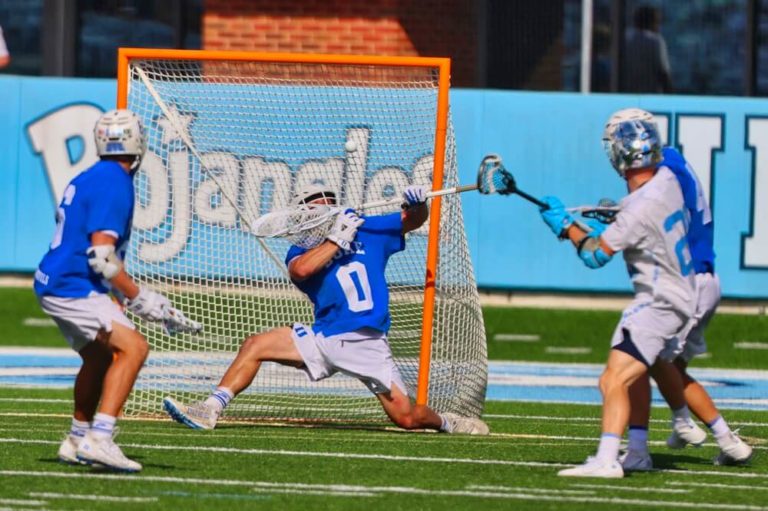
Table of Contents
Basic Goalie Rules
Each team must have a fully equipped goalie on the field at all times: This may seem stupidly obvious, but it’s important to point out that lacrosse teams cannot play without a goalie. This is significant because, unlike the sport of hockey, a lacrosse team cannot “pull” their goalie to substitute him for another player in an effort to score more goals to catch up to the other team.
A lacrosse goalie can play the full length of the field: Even though you can’t swap your goalie for another type of player, goalies do have complete freedom to leave their goals and run down the field, carrying the ball like any other player would, and they are even allowed to shoot and score goals!
Goal crease: The goal crease is a circle on the field with a 9-foot radius that surrounds the goal. You can think of it as “base” for a goalie, affording them added protection against being harassed by opposing players.
Contact rules: If a lacrosse goalie is outside the crease, he is basically treated like any other player in terms of rules for contact–he can check (hit) and be checked by other players within the rules of the game. If, however, the goalie is within the crease, it is illegal for opposing players to make any kind of contact with the goalie or the goalie’s stick. This is true even if the goalie doesn’t have the ball. One more thing to know if that, whether within the crease or not, goalies have no immunity against committing penalties. Their actions are governed by the same rules as everyone else.
Leaving the crease: Because they have so much protection within the crease, it would be unfair and disruptive to the game to just let goalies hang out there with the ball all day. That’s why goalies are given a 4-second time limit once they gain possession of the ball to either pass it to a teammate or leave the crease with it themselves. And if the goalie does leave the crease with the ball, he can’t go back into the crease until he gets rid of the ball.
Goalie equipment: Below we’ll tackle the list of required equipment to be on the field as a lacrosse goalie. But there’s one other important thing to note about a goalie’s equipment during the flow of the game. Both for safety and fairness reasons, a goalie can get the referee to blow the whistle and stop play if he notices a piece of his equipment (including his stick) is damaged.
What Gear Does a Lacrosse Goalie Need?
Boys’ and men’s lacrosse are physical games that involve a lot of contact and for that reason protective equipment is important for all players.
This is especially true in the case of lacrosse goalies who are tasked with repeatedly stepping in front of solid rubber balls being fired off at 90+ mph. They therefore need to be the most well-protected players on the field.
Luckily, lacrosse equipment technology is constantly advancing, meaning that goalies are more protected today than ever before.
Lacrosse goalies wear equipment that is similar to that of other lacrosse players, but is a bit more specialized to provide increased padding and protection.
If you or your child are planning on playing goalie for the first time, it is important that you understand these subtle differences so that you don’t end up accidentally purchasing gear intended for non-goalie lacrosse players.
Furthermore, there are a few equipment items that are entirely unique to goalies and are necessary for playing the position.
- Required for boys' and mens' lacrosse goalies:
- Stick (shaft, head, pocket)
- Helmet with throat guard
- Chest protector
- Gloves
- Cleats or turf shoes
- Athletic cup
- Mouth guard
- Optional: leg protection
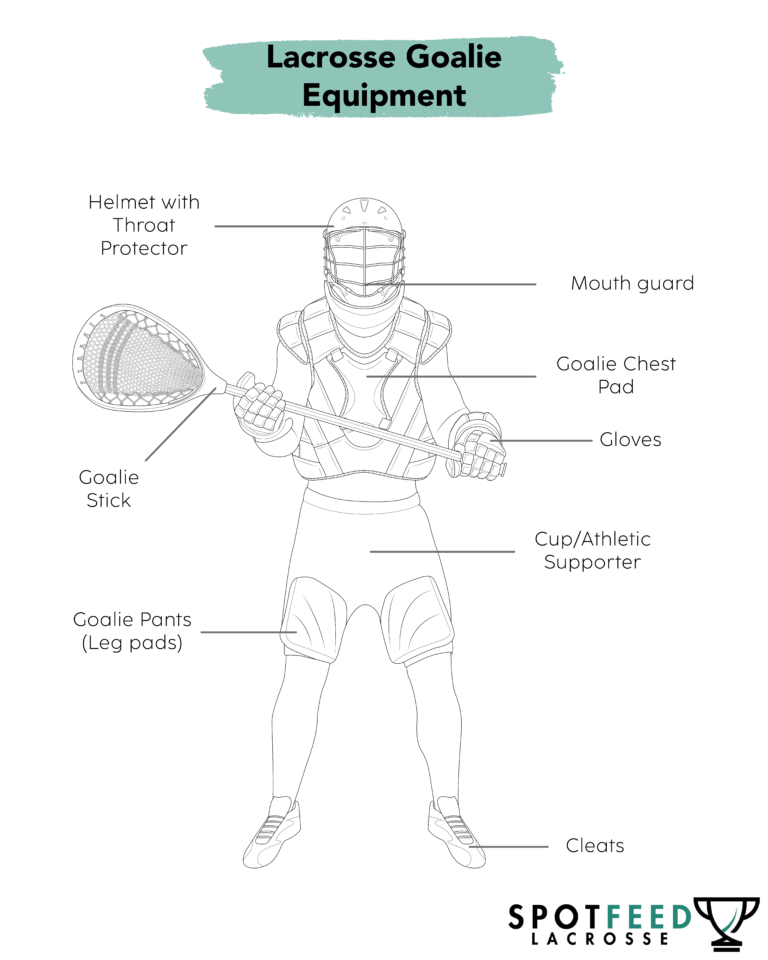
Goalie Sticks
What makes lacrosse goalie sticks different?
A lacrosse stick for any position is composed of 3 main parts: the shaft (the metal pole part), the head (the plastic part on top of the shaft), and the mesh pocket in the head, used to catch and throw the ball.
Where goalie sticks differ is in the size and shape of the head, and the length requirements for the overall stick (butt end of shaft to top of head).
Lacrosse goalie sticks will visually stand out on the field compared to others because of their unique heads, which are longer and wider than other lacrosse heads for a very intuitive reason: more surface area = more saves.
Lacrosse goalie heads have a width of 10-12 inches (at their widest point), compared to heads for other positions which are 6-10 inches wide. Similarly, goalie heads can be up to 16 inches long, compared to other heads at 10-12 inches.
The pole of a lacrosse goalie stick might not look too different from those of other players because, for the most part, it’s not. There are certain shafts that are made specifically with goalies in mind, but the basic design and dimensions are not unique.
However, goalies do have the most freedom in how long their sticks as a whole can be–anywhere from 40 to 72 inches. And at the youth level, they can even be as short as 37 inches (ages 11 and under).
How long should my lacrosse goalie stick be?
Because the range of allowable length for a goalie’s stick is so wide, you may be asking yourself how to decide on the right length for yourself. As you can imagine, different players have different preferences according to the pros and cons of long vs short sticks.
Long
Intuitively, a long stick seems to make the most sense for goalies, as it provides more reach to make saves further away from the body, disrupt passes in front of the goal, and clamp down on ground balls.
The extra length can also add some extra power to outlet passes, allowing you to send the ball down the field a further distance on clears.
The main downside of a lengthy goalie stick is the added weight, which can slow movement down a bit.
Short
The main reason goalies will opt for a shorter stick is to counteract the weight factor of a long stick. Shorter sticks are lighter and quicker to move around. This can provide an advantage in reaction time when attempting to stop fast shots.
Short length is also preferable for goalies who handle the ball outside of the crease on clears, allowing them to dodge and evade opposing players more easily.
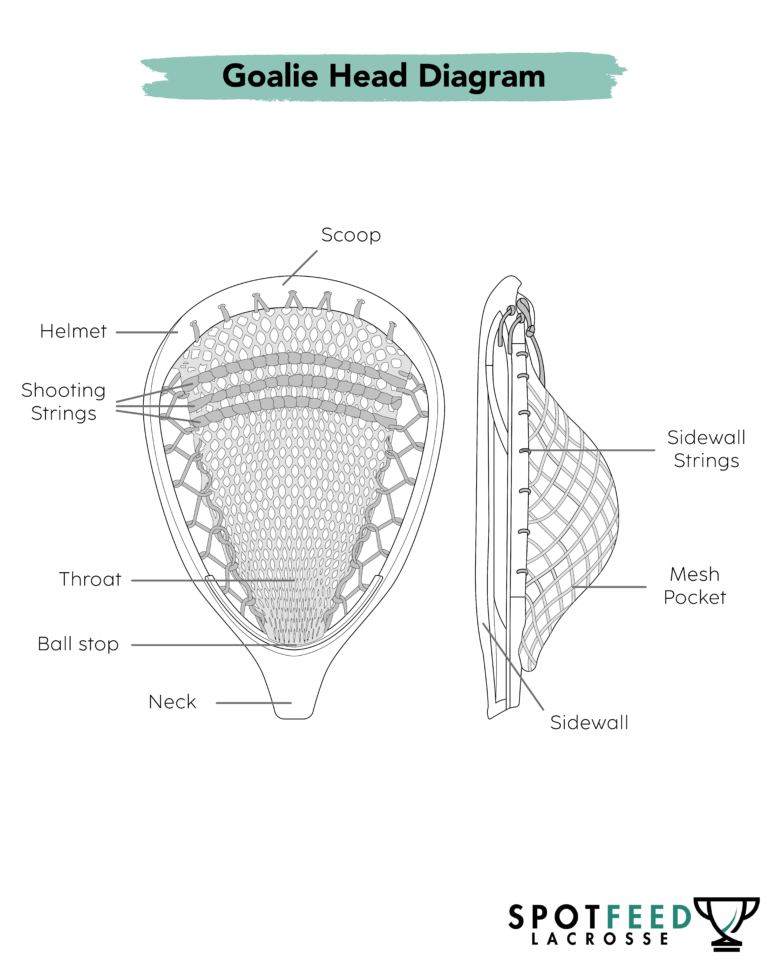
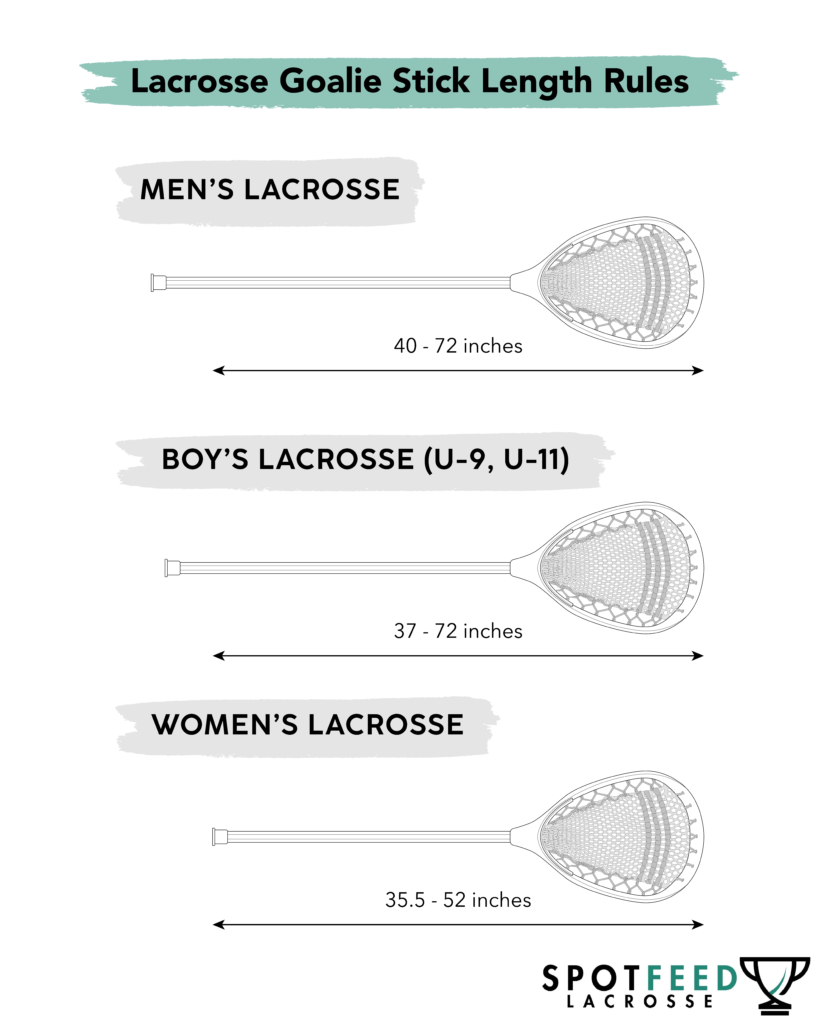
Other rules for goalie sticks
As with all other lacrosse positions, there are additional rules for lacrosse goalie sticks. Other than the basic length and width requirements, there are rules governing how a head is strung.
For a full explanation of these rules, check out our article on stick legality.
However, new players and new goalies shouldn’t worry too much about this. There are great options both for complete goalie sticks and pre-strung goalie heads.
And as for the shafts and heads themselves, the manufacturers would quickly go out of business if they were making gear that wasn’t legal for play!
So don’t stress too much over stick rules for now.
Head and Neck Equipment
Lacrosse goalies must wear helmets, and they wear the same helmets as other players on the field.
However, there are two helmet add-on items–one required and one optional–that provide additional protection for goalies.
Required: throat guard–this is a crescent-shaped piece of plastic that attaches on to the bottom part of the helmet in order to protect the neck and throat area from the ball. Some players attach them using zip ties, while others actually drill holes into the sides of the helmet to attach it with screws. Throat guards are required for all lacrosse goalies.
Optional: outer shell protection–there are two items that can be attached to the outside of the helmet to provide extra protection. They are not legal for games, but can be used in practices.
Lexi shield: hard shield that attaches to the forehead area of the helmet
Guardian cap: foam padding that covers the entire helmet
Lacrosse goalies can suffer concussions as a result of impacts from hard shots. It is therefore very important that you get a high quality, NOCSAE certified helmet that fits properly so that it will work correctly.
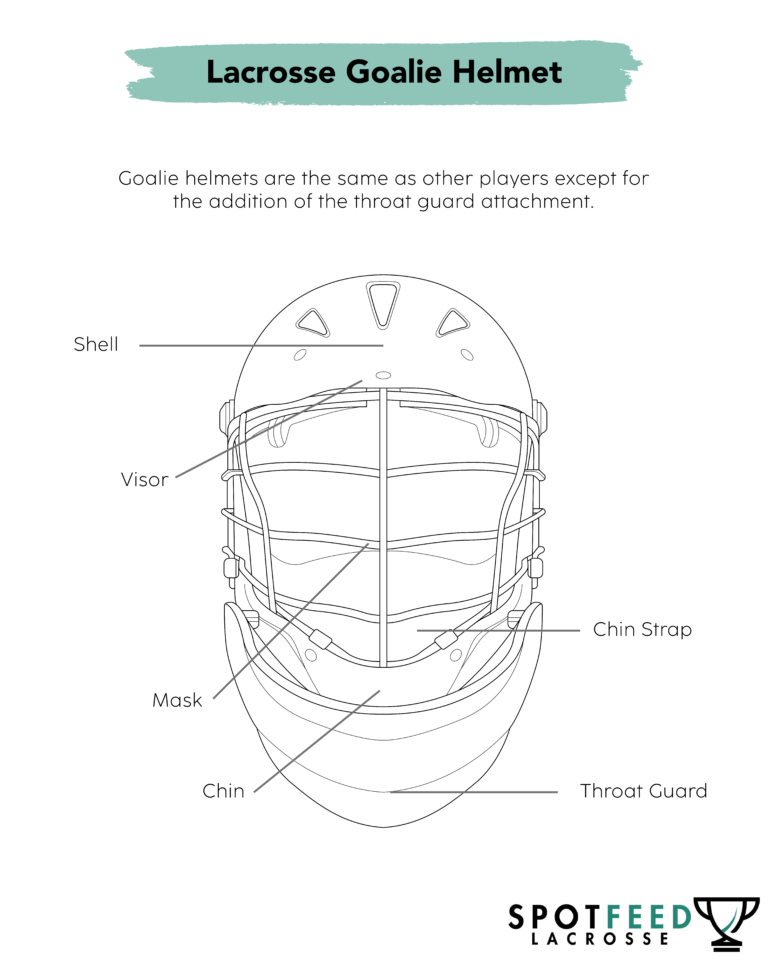
Goalie Chest Protector
A lacrosse goalie chest protector is similar to the shoulder pads worn by other players: it protects the chest, shoulders, and–to some extent–the back. Goalie chest protectors differ in that the padding in these areas is more substantial and they extend further down to protect the abdomen as well.
This is arguably the most important piece of gear for lacrosse goalies, not just for the obvious reasons, but because of the protection they are designed to offer against the most dangerous (yet incredibly rare) lacrosse injury: commotio cordis, a stopping of the heart that can occur due to high velocity balls impacting the chest.
All modern shoulder pads and goalie chest protectors are designed to prevent this from happening, making it an exceedingly rare occurrence and therefore not a cause for major concern as long as you have the proper goalie equipment.
Your best bet is to buy a chest protector that was recently released so that you know it has the latest technology built in to work correctly.

Goalie Gloves
Lacrosse goalies do wear gloves that are, again, very similar to those of players at other positions but reinforced with more padding. These special gloves provide many necessary benefits for goalies.
Lacrosse goalie gloves have tougher, stiffer protection on the top part of the hand than other gloves, but the most important and notable difference is the much thicker thumb protection, as the thumb is one of the areas on a goalie’s body that is most prone to getting hit.
Lacrosse goalie gloves are also designed to fit a bit more snugly. The tight fit offers added protection from impacts, but also provides better grip on the stick.
Lastly, lacrosse goalies can wear gloves of any color–they are the only ones who do not have to wear gloves in their team’s uniform colors.
Make sure to get a good pair of gloves so that you’re well-protected.
Arm Protection
Arm pads (also known as elbow pads) are only required for youth players (ages 15 and under), but adult goalies are allowed to wear them as well if they choose to do so. Arm pads are primarily designed to offer protection for the elbow, but they also cover parts of the arms.
The arm pads that boys’ lacrosse goalies wear are the same as those worn by players at other positions, so no need to search for goalie-specific arm pads or elbow pads–you likely won’t find any!
Arm pads are still allowed at the men’s level, but very few men’s lacrosse goalies wear them, for two reasons: 1) they can restrict speed and range of motion; 2) it is unlikely for a goalie to get hit with a shot in the outer arm area (on and around the elbow), which is the area that arm pads protect.
The same is true for youth players, but the requirement still stands for them as an extra precautionary measure, as their bones are still developing and are therefore weaker than those of adults.
Other Required Goalie Equipment
Cleats/Turf shoes
There are no goalie-specific shoes in lacrosse, but as with all players on the field, goalies must have shoes that provide proper traction so as to minimize slippage injuries that can occur from sudden sharp movements.
Outdoor lacrosse is played on fields that are either grass or turf. Lacrosse cleats–much like those for football and soccer–are essential for playing on grass and do well on turf as well. Turf shoes are specifically designed for turf surfaces but do not do as well on grass.
If you know you will be playing only on a turf field, then turf shoes should suit you well. If however, you play on a travel or school team, chances are you will have to play on grass on at least some occasions, in which case you should get cleats.
When in doubt, get cleats since they will work correctly on all outdoor lacrosse field surfaces.
Cup
An athletic cup is essential for protecting a highly vulnerable region (the male genitals) from forceful impacts. Wearing a cup is not always mandatory for all lacrosse players but is always mandatory for male goalies.
Furthermore, while you can wear a regular cup as a goalie, it is highly, highly advisable that you wear a goalie-specific cup to provide maximum protection.
Goalie cups provide many benefits; they add extra protection not only to the cup part itself, but to the lower abdomen as well.
As a goalie in boys’ or men’s lacrosse, this is one item of gear where you definitely do not want to cut corners, either in terms of buying something cheap or buying something slim and light. Get a cup made with modern technology.
And remember that proper fit is essential for ensuring that your cup will work correctly.
Mouth guard
All lacrosse players are required to wear mouth guards while on the field. There are no goalie-specific mouth guards, but it is, once again, vital for goalies to have the most protective and best-fitting mouth guards they can find.
Mouth guards are important not just for protecting teeth, but for preventing concussions, as they provide shock absorption for the whole skull.
When in doubt about which mouth guard to choose, you can consult your dentist, especially if you wear braces or require other accommodations.
Mouth guard technology has come a long way and there are plenty of options for styles to suit everyone’s needs.
Lacrosse bag
This isn’t exactly a requirement, but if you’ve made it this far and read about how much goalie equipment you need, it will probably be apparent why you would want a good bag to be able to lug all that gear around.
Leg Protection
Can lacrosse goalies wear leg pads?
Yes, lacrosse goalies can wear leg pads. Whether they do or not is another story.
The fact that people even ask this question speaks to the fact that it is rare to see lacrosse goalies wearing leg protection.
Some goalies claim they find their range of motion inhibited by leg pads, but the truth is that their many benefits far outweigh their drawbacks. Technology has advanced far enough that there are plenty of options for leg protection that feel almost weightless.
Sweatpants
The most common form of leg protection, by far, to see on a men’s lacrosse goalie is sweatpants. There are many benefits to wearing sweatpants as a goalie:
Padding: it may not be much, but something is better than nothing and even sweatpants will cushion the impact of a shot a bit.
Extra surface area: whether you wear leg protection or not, you’ll be using your legs a lot to make saves. Sweatpants make a marginal difference in how much surface area you have on your legs to stop a shot.
Weather: lacrosse is usually a winter/spring sport. In many parts of the US, that means cold weather and snow. In such cases, sweatpants for lacrosse goalies provide the same benefit they provide for the rest of us: an extra layer of warmth. This is nice not just for comfort, but also because warmer legs stay looser, making movement more fluid and less risky for injuries.
Cover: If you care about protecting both your legs and your image of masculinity, sweatpants will cover up the additional leg protection you’re secretly and shamefully wearing underneath.
Other leg protection options
Hockey pants, Lacrosse pants, Football pants
These are three options for goalie pants, which cover the upper parts of the legs. Hockey pants are usually the bulkiest of the three and are not a very popular choice for lacrosse goalie pants. In some cases, they may not even be legal because of how bulky they are.
Lacrosse goalie pants and football pants fit more slimly, protecting the thighs with some thin padding. They also usually provide some extra padding to the groin area and can help keep a cup stay in place better. Football pants usually come down a bit further and may provide some knee protection as well.
Shin guards
Shin guards are highly frowned upon for macho-man reasons, but are a smart choice if you want to protect your shins and have the fearlessness against low shots that comes with leg protection.
Again, if you’re worried about what others think, you can always just slap a pair of sweatpants over them.
One thing to note is that it’s best to go with soccer or ball hockey shin guards, as opposed to ice hockey shin guards which will limit your movement and may not be legal if too bulky.
Knee pads
Slim knee pads are a good way to add a little bit of protection against shots, as well as protection against scraping up your knees on the ground if you need to drop down or dive to make a save.
How do You Put on Lacrosse Goalie Equipment?
This is a bit of a learning process. For the most part, lacrosse goalie equipment is intuitive enough to put on, but every player has his own idiosyncrasies when it comes to the exact order and ways in which they put on their gear.
But here are a couple quick rules of thumb for putting on goalie equipment:
Dress from the bottom up: Anything you put on your upper body is going to restrict your mobility in bending down to put on lower body gear. This is true of all players, not just goalies. For that reason most players will follow some variation of the following sequence of equipment items:
1) athletic cup, 2) jock/compression shorts, 3) leg protection (lacrosse or football pants, or shin guards and knee pads), 4) shorts or sweatpants, 5) cleats/turf shoes, 6) chest protector, 7) arm pads, 8) mouth guard, 9) helmet, 10) gloves
Make sure everything fits snugly (but not too tight): If there’s too much space between your pads and your body, you won’t be protected as well. Your chest protector and arm pads, helmet, and shoes can all be tightened or loosened, usually with velcro, straps, and laces, respectively.
Don’t go overboard, though. If you make your goalie equipment too tight it can restrict your blood flow and your movement, and can otherwise impact safety. To make sure everything will work correctly, you want to adjust your gear to have just a little give to it when impacts occur, especially your helmet. If you shake your head up and down and side to side, you should be able to feel your helmet rock around a bit, indicating that there’s still some space between it and your head. This is an easy way to check if your helmet fits right.
For more specific guidance, check with a teammate, coach, retailer, or fitting guide. All new helmets and some other goalie equipment should come with a physical manual, but fitting guides can also be found online on the manufacturer’s site. There are many other online resources to guide you as well.
What's it Take to be a Good Goalie in Lacrosse?
Necessary skills
Contrary to popular opinion and intuition, you don’t need to be a physical monster to play goalie. Many successful goalies are quite short. Height and weight matter far less than the following athletic abilities:
Hand-eye coordination
Agility and footspeed
Quick hands
Strong stick skills
Field vision and ability to read plays (otherwise known as “lacrosse IQ”)
How do you play goalie in lacrosse?
Obviously, the most important part of being a lacrosse goalie is saving shots. You’ll give yourself the best shot at making saves if you do these three things well:
Talk to your players: Your most important job is to watch the ball, but you also have the best field of vision of what the opposing team as a whole is up to. Your defenders are there to help prevent high quality shots, but you can help them help you by calling out when you see something that they might not: a wide open opposing player, for instance. Part of your job is to tell your players where they should be to make it as hard on the opposing players as possible to shoot.
Good stance: Your stance as a goalie is very important. You want to be in a stance that feels stable but also allows you to make quick explosive movements in any direction. Most goalies recommend standing with your feet at least shoulder width apart with a slight bend in your knees and straight (but not stiff) back.
The save itself: When a shot does come at you, it’s recommended that you lead with your top hand to make the save. In other words, don’t waste time maneuvering your whole body to meet a shot with your stick right side up every time. It’s quicker to just focus on moving your top hand to where the ball is going, even if that means inverting your stick in strange ways. It will feel awkward at first, but with training you will get used to it and your reaction time will only improve.
Practice and Drills
The best way to train as a lacrosse goalie is quite simply to just face a lot of shots.
However, doing so means having access to a field of some kind, a lacrosse goal, all your goalie equipment, and a teammate or friend who knows who to shoot a lacrosse ball (and also has gear of their own).
Obviously, this is not always possible, so you may be wondering what kinds of drills you can practice when you’re in a more limited setting.
With a partner
Again, hopefully you have another lacrosse player who can practice shooting on you. If not, having an extra person can still provide many benefits, whether they know how to play lacrosse or not.
If you have a practice goal of some kind, you can stand in front of it and have someone simply throw a ball at it by hand. You can do this with or without goalie equipment, since even catching the ball by hand (without a stick) will help to exercise your footwork, reaction time, and hand-eye coordination.
Another great drill to do with your stick and the assistance of a teammate, friend, or parent is to stand facing either a wall or a lacrosse rebounder, maybe about 10 feet away. Have your partner stand behind you, throwing a ball at the wall so that you can’t see where they’re aiming. The ball will bounce off the wall and come back at you, giving you very little time to react and try saving the ball.
This simulates in-game scenarios well, when you don’t necessarily know when a shot is coming and where it’s going until the last moment.
How do you practice as a lacrosse goalie by yourself?
With a wall
The best way to practice stick skills for any lacrosse player, regardless of position, is “wall ball.” It’s a very simple thing: stand in front of a wall with your stick and a ball and repeatedly throw the ball against the wall, catch the rebound, throw it again, and so on. But despite this simplicity, wall ball provides so many benefits for lacrosse players at all positions and all skill levels.
The beauty of wall ball is it can be as simple or complex as you make it.
Want to just build up strength, stamina, and hand-eye coordination? Stand close to the wall and just get lost in the back-and-forth rhythm. Want to practice long outlet passes? Stand far away and aim for particular spots on the wall. Want to work on saves? Throw the ball hard against the wall in particular spots such that you know the rebound will send the ball in a hard-to-reach spot, making you contort yourself quickly for the more difficult saves you can expect in a game.
There’s endless creative potential with wall ball. Every player has his own routine of drills. If you need inspiration when starting out, there’s plenty of YouTube videos and websites where you can find fellow goalies sharing their own personal drills. But over time, you’ll find what works for you and develop your own routines.
No wall (Items to purchase for solo training)
If you don’t have access to a goal, a wall, a rebounder, or a partner, don’t worry! There’s still a lot you can do purely by yourself.
Lifting weights: Strength is always important for any position in any sport. As a goalie, you need to be able to move explosively and hitting the gym can definitely help with that if you do the right exercises to build quick reflexes, reaction time, and explosion. Focus on core strength and plyometric movements to really build explosiveness.
Sprints: This will help develop the fast-twitch muscles needed for quick reactions as well as general cardio endurance and stamina.
Agility ladder: If you haven’t seen these before, they’re basically flat ladder-shaped sheets that you can use for footwork drills. The spaces in between the “ladder steps” are just wide enough to fit both of your feet in, making it challenging to move quickly through the spaces without touching the ladder itself. There are lots of different drills designed for agility ladders to practice different types of footwork.
Ideally, this should be used on grass or turf with cleats/turf shoes on to really simulate game play. But if that’s not possible, you can still use this indoors on any flat surface.
Cones: Similar to the agility ladder, you can set up plastic cones in whatever array you’d like and do footwork drills, weaving in and out of the cones without touching them.
Reaction ball: A reaction ball is comprised of multiple rounded nodes, such that when you bounce it on a flat surface, instead of bouncing straight up, it will bounce in an unpredictable direction. You don’t need a stick or any of your lacrosse goalie equipment to use this for working on reaction time. From a standing position, throw the reaction ball straight down on a hard surface and try to “save” it when it bounces back. You can try catching it with your top stick hand, or you can try saving it with your legs or feet.
Any other bouncy ball: A reaction ball will provide the most challenge for the above drill, but really you can do it with any ball that bounces: a lacrosse ball, tennis ball, even a tiny toy bouncy ball. Even if you know it’ll bounce straight up and down, it still takes focus and hand-eye coordination to catch it each time.
Sand: Sand? yes, sand. Sand is good for two purposes. If you have access to a beach, running on sand is a great way to improve the explosivity of your foot movements because it is harder to move in than grass.
But you can also use a similar principle to work on your stick skills. Most lacrosse shafts are hollow. If you take the end cap off the bottom, you can fill your stick with sand, or some other substance, to make it heavier.
Practicing any of the above stick-related drills with a weighted stick will help build up strength and quickness over time, allowing you to make more saves and throw longer outlet passes with ease.
FAQs
In lacrosse, the term “goalie” is more common than alternative terms like “goalkeeper” or “goaltender” that are used for other sports.
Playing goalie is hard. It is, in fact, often seen as the hardest position in the game. The shots a goalie faces in today’s game–at the men’s lacrosse level, at least–can be as fast as 90+ mph! A good save percentage in lacrosse is only 50-60%. That means even the best goalies are only going to be able to stop a little over half of the shots that make it to the cage. But because of how difficult it is, learning how to play goalie well can be a very rewarding experience. Few players are brave enough to answer the call, but those who stick with it can become the heroes of their teams!
